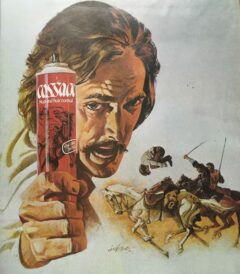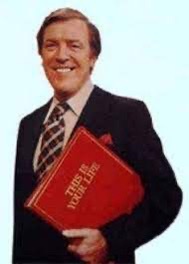
It was a 60s and 70s must-see TV appointment, but were the ‘subjects’ really that enthusiastic?
Throughout the 60s and 70s many programmes became must-see events for all the family. Maybe this was because the quality of output was so much better than much of today’s abundant but formulaic offerings. But we only had three channels and programme makers could concentrate producing high quality fare because there was so little competition and channels really did want to challenge as well as entertain. That said, for every Monty Python’s Flying Circus there were five Not in Front Of The Childrens or its equivalents. We were also probably more accepting of the dross that was served up to us. TV was still relatively new and constantly evolving.
One of those must-see events was a programme that spanned the years 1955 to 2003 and could rely on millions tuning in to every episode. We all were fascinated to learn of who that week’s ‘victim’ was going to be and it was this weekly mystery that probably allowed the series to sustain for so long. And, hey, they’ll have their celebrity pals on too! Of course, I’m talking about This Is Your Life.
The programme was synonymous with Eamonn Andrews, a ubiquitous 50s and 60s TV face. His career trajectory is a curious one. Born in Dublin in 1922 he began as a sports, mainly boxing, commentator.
In 1951 he somehow got the gig as the presenter of the BBC’s sophisticated new US imported panel game What’s My Line which lasted until 1963 and was revived a few times by various TV channels until 1996. The original US version was memorable for the high calibre of celebrity mystery guests who tried to fool the panel. Guests included an A-Z of Hollywood stars such as Sean Connery, Alfred Hitchcock, Big John Wayne and, surreally, Salvador Dali.
With The Eamonn Andrews Show in the mid-late 60s he pioneered the chat show as we now know it, although his interviewing style was savagely lampooned by writer Marty Feldman on the brilliant Round The Horne with Bill Pertwee as Seamus Android (See Marty Feldman: A Criminally Forgotten Comedy Genius). Most people of my age will remember him as the unlikely front man of Crackerjack between 1955-64, although no more unlikely than either ex-newsreader Michael Aspel (who would also take over from him on TIYL after his untimely death) or ubiquitous Genxculture figure Ed ‘Stewpot’ Stewart, who both succeeded him. Inevitable 70s stints as Miss World host and unchallenging 70s afternoon fare Whose Baby would also follow.
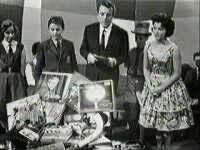
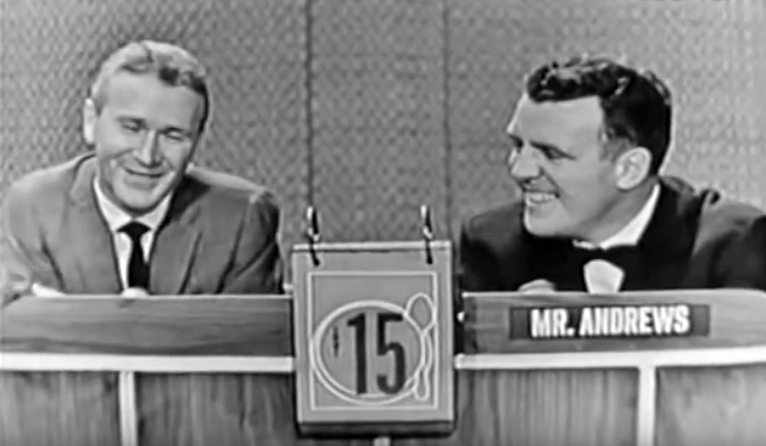
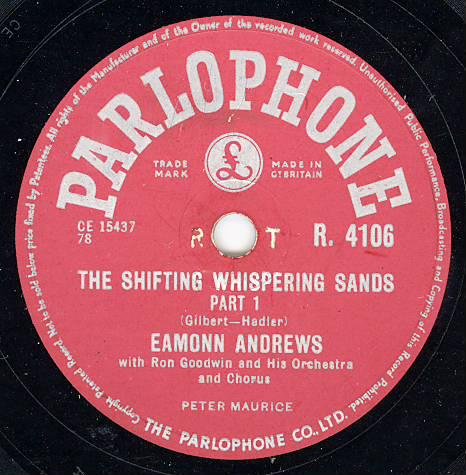
Eamonn even had a hit record in 1956 such was his fame! His spoken, George Martin produced, version of The Shifting Whispering Sands reached a heady No.18 in The Hit Parade. It has to be said that his booming Irish sports commentator voice is an odd accompaniment to the story of a man lost and facing death in an American desert, but who cared? It was Our Eamonn. The song even made it on to Kenny Everett’s 1978 album The World’s Worst Record Show. And he was in exalted company. Also featured on this album were William Shatner’s groundbreaking and utterly unique version of Lucy In The Sky With Diamonds, which has to be heard to be believed, Lord Rockingham’s XI’s Wee Tom and a mighty 7 (seven) records by Jess Conrad. I saw Jess Conrad on one of those many lugubrious ITV afternoon property programmes some years ago and he referred to himself in the third person throughout. ‘Yes, Jess Conrad really loves this bathroom suite.’ I doubt ‘Jess Conrad‘ would have been too enamoured of this statistic.
Eamonn Andrews died suddenly in 1987 at the criminally young age of 64 having contracted a virus on a plane journey which resulted in heart failure. His career was probably more successful than he could ever have imagined and he was certainly seen as a safe and uncontroversial pair of hands for the buttoned-up 50s and 60s. It was impossible to dislike Eamonn Andrews and anyone of a certain age if asked about what they remember of him would certainly associate him with TIYL.
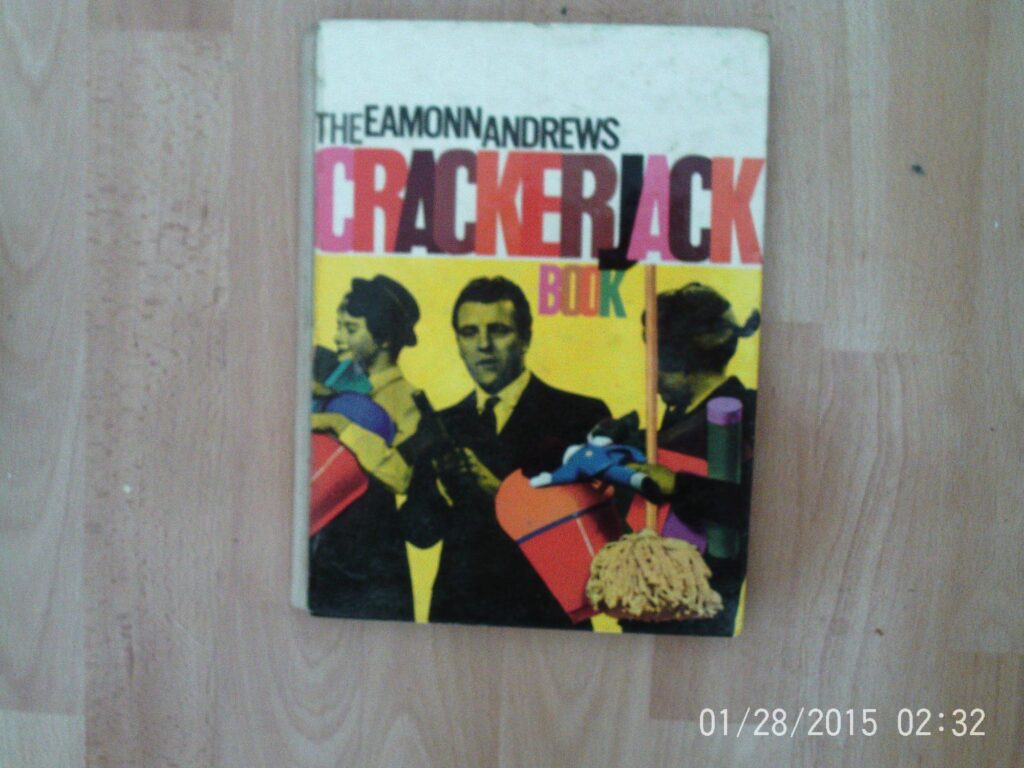
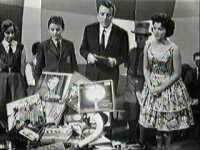
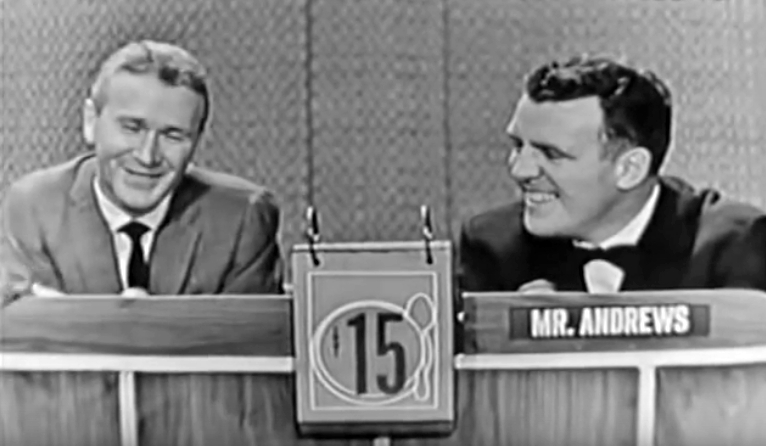
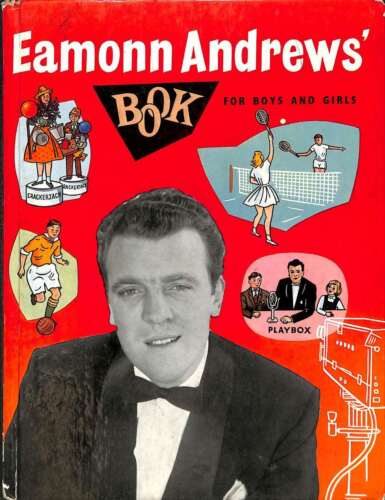
It was only while watching BBC 4’s excellent biopic of Hattie Jacques a few years ago that it suddenly struck me how excruciating it must have been for so many of the TIYL subjects. Have a look at some of the openings when compere Eamonn Andrews surprises them and see how many expressions momentarily drop until they realise that they should really go along with it as it would not only show them up to the Great British Viewing Public as spoilsports or wet blankets but also disappoint the hordes of relatives and pals (and probable unknowns) already lined up behind the sliding doors, ready to regale with yet another hilarious anecdote. I genuinely felt for them. If I was famous I’d completely hate every agonising, unbearable moment of the half hour trying to remember who this person who claims to know me actually is. Or forcing myself to appear jolly when the story related is just embarrassing.
Hattie Jacques was the ‘victim’, an appropriate word given the background to this particular show, on Tuesday 12 February 1963. Her idyllic home life with her husband, the great John Le Mesurier, lovely family and successful career was highlighted throughout the show. John Le Mesurier’s rather restrained response to Eamonn’s question along the lines of ‘Tell us how wonderful Hattie is?’ disguised a quite agonising reality.
In the BBC4 2011 biopic with Ruth Jones excellent as Hattie, she is walking back to her car after the show and she turns to Le Mesurier and says ‘Well that was perfectly ghastly.’ Few people knew at the time that Hattie was living with her boyfriend and Le Mesurier was exiled to another bedroom in the same family home. Few people at this very conventional time would even have considered a situation such as this could exist. But it did and Hattie and John had to go through the ‘ghastly’ ritual of pretending to be an exceptionally happy showbiz couple, one that we all could be jealous of. This was the moment when I realised what a bogus and disingenuous programme This Is Your Life could be for many well known people. It wasn’t the fault of the producers really. They could only go by what associates of the ‘victim’ said about them and they were getting millions of viewers every week. Why change?
A tiny clue emerged on 6 February 1961 when Spurs‘ captain Danny Blanchflower was the first, and one of very few, who refused Eamonn’s Big Red Book. It shocked the nation as everyone thought that all well-known people were desperate to be chosen for this show. And I can’t help but feel absolute respect for Danny who had the courage and intelligence to understand that this really was not the ‘honour’ it was cracked up to be and politely turned it down. Despite this he was still hounded by a frenzied press determined to find out how this preposterous decision could have been arrived at. His reason was perfectly logical;
I did not want to expose myself to the public without having the right to say ‘yes or no’. You get shanghaiid into this situation where you are suddenly exposed to something. Had it been before a studio audience ..I would have still have said ‘no.’
The shockwaves that ran through the country distracted people from realising that Danny’s was probably not an isolated reaction.
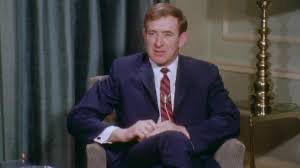
Some month’s ago the ever excellent Talking Pictures TV broadcast a US edition of TIYL from 1954 featuring a visibly ageing Laurel and Hardy. They were sitting chatting to friends in their hotel room, glad of the peace and quiet no doubt, when the Eamonn Andrews‘ US equivalent, Ralph Edwards, burst in with a TV crew and ‘whisked’ them off to the Burbank studios where hordes of fans and admirers were waiting. During the next excruciating 30 minutes Edwards played them voice clips and said ‘Do you recognise this voice?’. The poor old buggers didn’t remember any of them, even when their names were given and they walked on set, and why should they? The length and depth of their film careers must have had them coming into contact with hundreds of people. But, to their immense credit, they were hugely courteous, played along and did a lot of nodding and smiling. I couldn’t help feeling there was something so wrong about ‘shanghaiing’ these two old men who just looked exhausted and would rather have been anywhere else, ideally quietly watching telly in their hotel rooms. The benign potential cruelty of TIYL began to take shape in my head.
Another rare refusal I actually witnessed took place on 20 February 1974 and involved Dr. Gordon Osteler, better know to many as Richard Gordon, writer of the rather mediocre ‘Doctor‘ books, radio and TV series such as Doctor In The House and Doctor In Charge. As Eamonn ‘shanghaied’ him with the Big Red Book, Osteler turned on his heels shouting back ‘Balls!’ As I, along with a few other million viewers, lurched back in my chair, not quite believing what I was seeing and hearing here, Eamonn pursued him entreating, ‘Oh…come on..’, in other words don’t be such a miserable git, when the pictures suddenly disappeared and the Thames logo and jingle reappeared. Once again we get the TIYL theme and opening credits (Da-Da-Da-DA) and Eamonn has miraculously been transported to Kempton Park racecourse and who is this having the Big Red Book thrust in his face? Why it’s ubiquitous character actor Sam Kydd! And he wasn’t saying no! Sam Kydd’s son Jonathon gives an interesting insight into what it was like being involved in TIYL in the Youtube video below, not least the bizarre quality and choice of guests for his dad’s show. Sam had no idea who one ‘old school friend’ was, he scarcely knew Beryl Reid and had never even met the clergyman. I can’t help but believe that Sam Kydd’s TIYL experience would have been very similar to many other ‘victims.’ Let’s not forget that TIYL was about entertainment and many subjects lives would have been pretty dull had it not been for the ‘surprise’ showbiz people who just wanted to pay their respects. Whether they knew the subject or not.
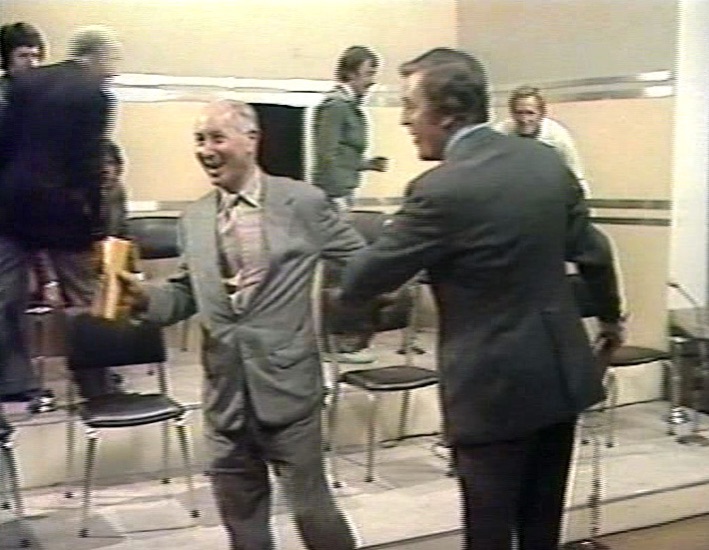
Eamonn manhandles Richard Gordon in an attempt to stop him escaping.
With appearances in over 200 films on his CV one can’t help but feel poor old Sam might also have felt a tad miffed at the fact he was only featured because someone they thought was more interesting had bumped them, at least initially.
And talking of the great Beryl Reid, she was the subject on 17 March 1976 and, according to her biographer, was less than happy with the outcome. One of the guests was an old boyfriend she hadn’t seen for years and wasn’t particularly bothered about seeing again. I’m sure we all have old flames we really wonder how we ended up with and wouldn’t be keen to meet up with again, never mind in front of an audience of 8 million people. Sam Kydd might have been slightly perplexed as to why she rolled up on his ‘Life’ but she did appear as a guest on 10 other shows including those of Harry Andrews, whose male partner of 30 years was excluded from his show, Bernard Cribbens, Patrick Cargill and, interestingly for Genxculture, Nat Jackley who 13 years previously had appeared in The Beatles’ Magical Mystery Tour (See Magical Mystery Tour: What A Long Strange Trip It Was). A record? Not if you consider the great Peter Ustinov’s 14 guest appearances and not one but two shows of his own ‘life’ on top of that or that of a certain other individual who we shall come to shortly. Peter Davison, riding high as Doctor Who at the time, was also slightly surprised as he had only met Beryl Reid twice. But if a researcher got in touch and asked, ‘Would you appear on this person’s This Is Your Life?‘ and you happened to be free that evening it would seem a little churlish, not to say disrespectful, to turn the request down.
Osteler later relented and his show went out a couple of weeks later. And what a dull old show it was. It was clear he really didn’t want to be there and came over as a cold fish, right down to shaking hands with his children who were marched on and didn’t exchange a word with him, I seem to remember. But who could blame him for being so pissed off?
It was also rare for ‘victims’ to find out that they were being ‘done’ on TIYL although I’m sure some did and just kept quiet about it. One who didn’t was the great Ronnie Barker. Having become increasingly suspicious of his wife’s behaviour over a period of a few weeks he eventually confronted her about what was going on. She spilled the beans and the producers decided they couldn’t go ahead with it. This pleased Ron as he admitted in his autobiography a few years later that he wouldn’t have done it anyway. The very idea filled him with dread. He wasn’t averse, however, to not only appearing on TIYL but also being part of the sting, as he was in the case of his comedy partner Ronnie Corbett.
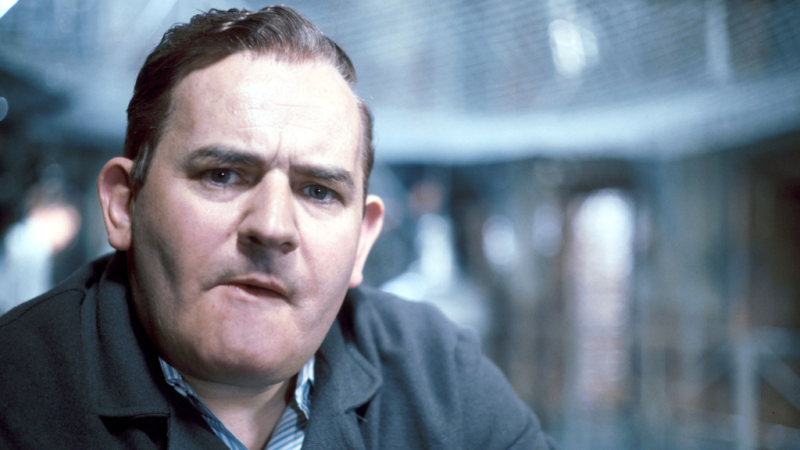
A few years before The Two Ronnies both Barker and Corbett were appearing regularly in Frost On Sunday. The last sketch of the last episode of the series series involved Corbett playing an ordinary bloke who was obsessed about Eamonn Andrews turning up at his door with the big red book. The punchline involved Barker coming into his house and saying ‘You’ll never guess who I just met outside?’, cue Andrews barging in with the big red book. But in this live sketch Andrews continued, ‘But Ronnie Corbett, this really is your life!’ A few days later the Ronnie Corbett TIYL was broadcast. Ronnie Corbett has written about this in his autobiography and described how he was very unhappy doing this sketch as he felt the two roles should have been reversed. I can’t help thinking that he maybe twigged what was going on but kept schtum about it.
In the early years of TIYL it was common for the show to feature almost as many ‘ordinary’ people as as famous faces. War heroes (it began only six years after the war ended) such as Douglas Bader, public servants and unsung charity workers all were given their own big red book. Even world renowned figures like Gladys Aylward and Chad Vara were subjects. Although laudable in their intentions, and this policy carried on to an extent right through until their final broadcasts, it was clear the vast majority of viewers really wanted to see ‘stars’ or as we refer to them now, ‘celebrities’. And, of course, it was inevitable some star from the silver screen would have been crowbarred into the guest list just to excite the TV audience, Beryl Reid perhaps?
The conservatism of the 60s and 70s viewing public not only required the likes of Hattie Jacques and John Le Mesurier to pretend their marriage was idyllic but also excluded many gay subjects from being honest about their private lives. I’m also fairly certain gay ‘subjects’ featured had their private lives and living arrangements brushed under the carpet. With performers such as Frankie Howerd, John Schlesinger, Harry Andrews and John Inman featured, looking back, it does seem strange that their partners of the time were not invited on to the show. Of course, homosexuality was deemed ‘illegal’ by the laws of the land up until 1967 so it wouldn’t have been possible to involve same sex partners up till then, but even after this it was not encouraged. Too much for a light entertainment audience to cope with. But it further underlined just how false the programme’s claim that this was the ‘life’ of a particular person when it clearly wasn’t.
It’s also awkward to think that TIYL featured an A-Z of Operation Yew Tree. Jimmy Savile was the subject twice and appeared as a guest on no fewer than 18 other shows including as diverse characters as wrestler Jackie Pallo, larger than life scientist Magnus Pyke, Pan’s Person Babs Lord and unpleasant hairy monster Dave Lee Travis. Not forgetting Rolf Harris, Gary Glitter (who I once shared an elevator with) and It’s A Knockout’s Stuart Hall. Well, they weren’t to know I suppose. I remember clearly watching Savile’s second appearance in 1970 and found the fact that he referred to his mother as The Duchess just a tad creepy.
Maybe I’m taking all this a bit seriously and, it’s fair to say, many subjects were only too happy to take part and probably enjoyed the experience thoroughly but there must have been many who found it all just excruciating. That said, we all watched and often enjoyed This Is Your Life and loved the mystery of who was going to be next to walk through those sliding doors. It was a broadcasting institution and featured a huge range of well known people as well as less well known but worthy individuals.
But, as Groucho Marx rightly said, who wants to be in an institution?
